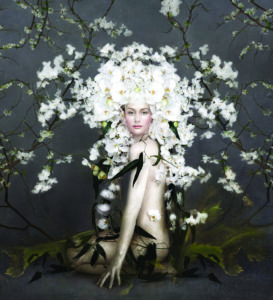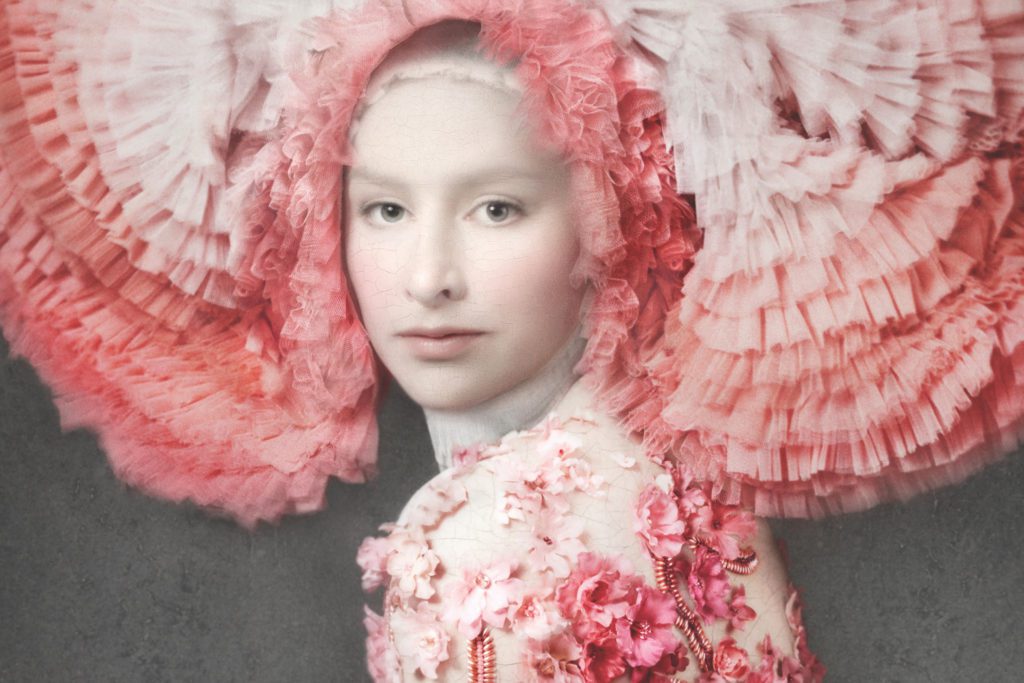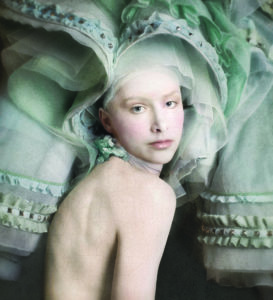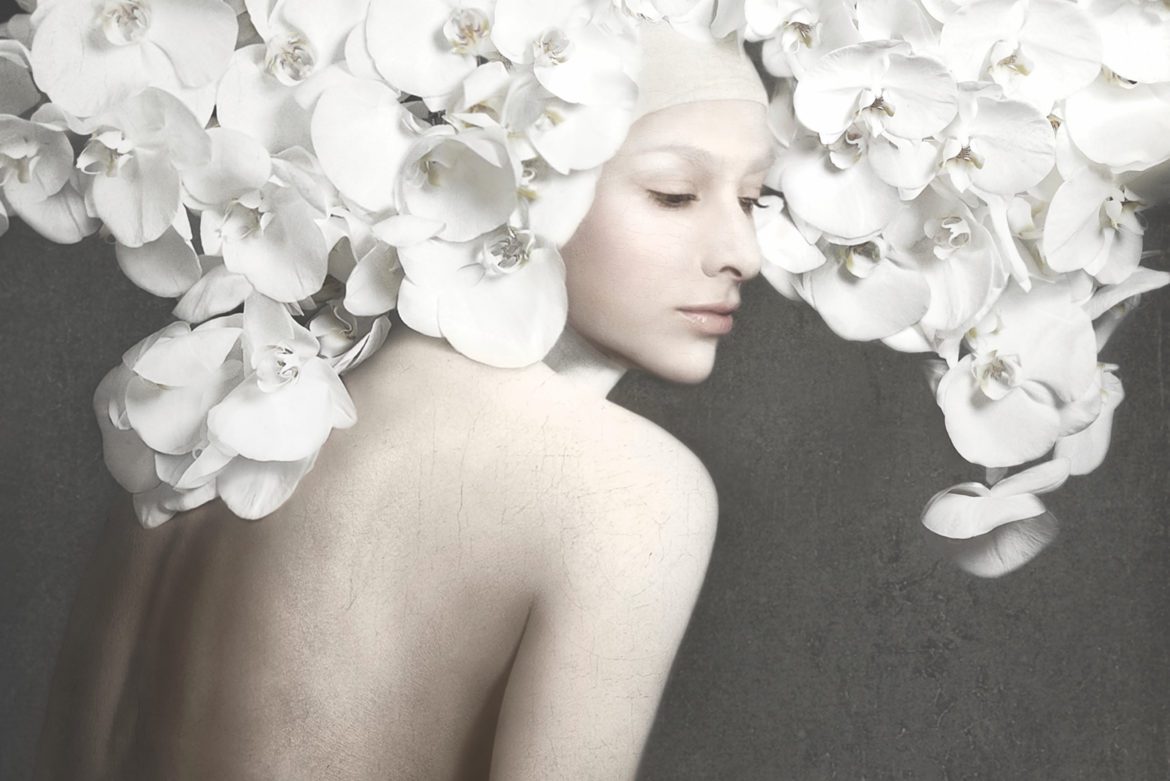“Her work soothes the eye and touches the soul, inspiring viewers to reconnect with their own higher calling, their soulful longing . . . to remind them to deepen their courage and humility, empower self–inquiry, and ask themselves to reach into their soul for greatness–and find that beauty is always there”
Internationally acclaimed Amsterdam-based artist Isabelle van Zeijl, reaches into the very depths of her soul to materialize her spirit in modernist photographic self-portraits that hearken to Dutch Golden Age artists such as Rembrandt van Rijn, Vermeer, and Franz Hals, and earlier still, to the Renaissance, when great masters such as Da Vinci and Botticelli captured feminine beauty on canvas as something divine and ethereal.

The raven-haired, strikingly beautiful artist aspired to be an actress when she was a young girl but lost her voice to the violence she was exposed to in those formative years. “So, I started to speak through my work,” she explains. “My work became my voice. In order to survive troubled times, I decided one day to turn my eye to all the beauty around me.” Fifteen years ago, Isabelle began exhibiting at exclusive shows, such as the London Art Fair and Art Miami and immediately captured the attention and enthusiasm of the international art scene. The Royal Opera Arcade Gallery and the Cynthia Corbett Gallery in London, the Christopher Martin Gallery
in Dallas, the Sponder Gallery in Miami, and other prominent art houses began representing her work; likewise, Brown’s Hotel in London and the Four Seasons Hotel George V in Paris.
“Isabelle is an extraordinarily talented fine art photographer whose artwork subverts conventional ideals of female beauty which is a theme we feel very passionate about at Harper’s Bazaar,” observed Frances Hedges, associate editor Harper’s Bazaar UK.

“In a contemporary art world that condemns beauty as camouflage for conceptual shallowness,
championing high aesthetics is nothing short of rebellion. Van Zeijl takes female beauty ideals from the past, and sabotages them in the context of today,” noted Wall Street International Magazine.
The essence of a woman in any expressionistic milieu—whether art, music, or dance—can effuse power, and transcend time and place. This is what Isabelle aspires to achieve, independently and alone, as she serves as model, creator, object, and subject of her own creations, reveling in the unadorned loveliness of her own nudity in almost every work she produces.
In a world consumed by anger and misogyny, the realm of women is plagued by sex and labor discrimination, belittling and bullying, scorn, and mental and physical brutality, and this toxic atmosphere caused Isabelle to reflect. “I asked myself what human being do I need to forge myself into, and how can I use my burden to bring light to make a change in the world? I decided to turn my eye to all that was beautiful around me. Bringing beauty, light and inspiration became my mission.”

Isabelle indeed captured beauty and light in her enigmatic “The Rebirth of the Dutch Flower Collection,” a series of delicate, almost otherworldly images the artist created during the worldwide epidemic lockdown, when she gathered discarded flowers that her local growers were unable to sell and repurposed them in her art as a symbol of rebirth. The growers were forced to destroy 400 million flowers in the first month of the COVID-19 lockdown, suffering a loss of more than 80 percent as a result of cancelled celebrations and orders from all over the world. When they heard her plan, they were anxious to collaborate with Isabelle. As one grower said, “Life is cyclical, like nature. After every difficulty there is always ease. We choose to share, to collaborate so as to grow together.” As the artist herself explained, “Flowers grow out of dark moments, the more difficulties, the more beautiful they become, they always tend to grow towards the light.” Ten percent of sales from “The Rebirth of the Dutch Flower Collection” go to The National Coalition Against Domestic Violence, which has seen a rise in cases since quarantine began. “We rise by lifting others,” the artist declares.
The language of flowers and their secret and symbolic meanings have expressed emotions and ideas for thousands of years. The practice of communicating through cryptological messages was practiced in Ancient Persia, in the Middle East, throughout the Middle Ages. The language of flowers is in the literature of William Shakespeare, Jane Austin, and both Charlotte and Emily Bront , and held significant importance in Victorian times. “Tussie-mussies,” or “talking bouquets” were nosegays or posies worn around the head or bodice not only as a fashion accessory, but to convey secret messages between lovers. Each variety had its own meaning: apple blossoms mean better things are to come, lavender means virtue, violets mean faithfulness, and roses’ meanings depend upon their color: white roses mean purity, yellow means friendship, etc., but the pink rose means grace, happiness, and gentleness. Isabelle cloaks herself with pink roses in “The Rebirth of the Dutch Flower Collection.” Surrounding herself with roses, she believes, shields her from negativity and empowers her with a gentle strength. Roses purify and fuel inspiration: “One day I decided to turn my eye to all that was beautiful around me. Beauty became my nutrition, my purifier, and a way to survive troubled times. Bringing beauty, hope and inspiration became my life, my purpose. I believe everyone has the perfect gift to give the world, and if each of us is freed up to give the gift that is uniquely ours to give, the world will be in total harmony,” the artist relates.

There are two purposes to art in any form: one, as a conduit for the artist to express herself and, two, to evoke a response from the viewer. It can be a reciprocal relationship that never is consummated, for rarely does the artist meet the people who view or own her work. For Isabelle, her work must emerge from a deeply, quietly subliminal level, for it is there where her creativity lives and thrives. For her—indeed, for any artist—the process is part intuitive, part spiritual, part philosophical, part emotional and part—always a part—of the artist’s very being. It is like a wave that crashes upon the shore, then recedes into the vast ocean. Art crashes into our consciousness, then recedes into the moment, leaving a trace of suggestion, just as the wave leaves a ribbon of foam on the beach. We sense more than we see in Isabelle’s “Moonshot Collection,” where she embarked upon a complex and long personal journey to find, in the wild beauty of horses, meaning in her own life. The spiritual significance of the horse has long held meaning in many cultures, past and present. It is about overcoming obstacles and facing adversity and is meant to remind us to take care of our emotional, mental, and spiritual wellbeing. Isabelle’s journey took her to the American West, to Moonshot Ranch in Aspen, Colorado. Every night she stood naked in the moonlight, in the trembling cold, and photographed herself with horses. It was a long and enduring process as the woman attempted to gain the horses’ trust before she could be the artist. To do so, she had to completely surrender herself and, in her journey, she found courage and humility; and rather than teach the horses to trust her, she learned trust from them and surrendered herself in ways she never knew possible; in seeking to achieve the impossible, she reached for the stars—and finally touched them. The result is a series of self-portraits of such unsettling beauty that only the subdued monochromatic palette of undulating contrasts of light and dark—sometimes
stark, other times with the luster of charmeuse silk—impose peace and calm. What better way to describe the creative soul of Isabelle Van Zeijl?
By Laurianna Della Rovere


